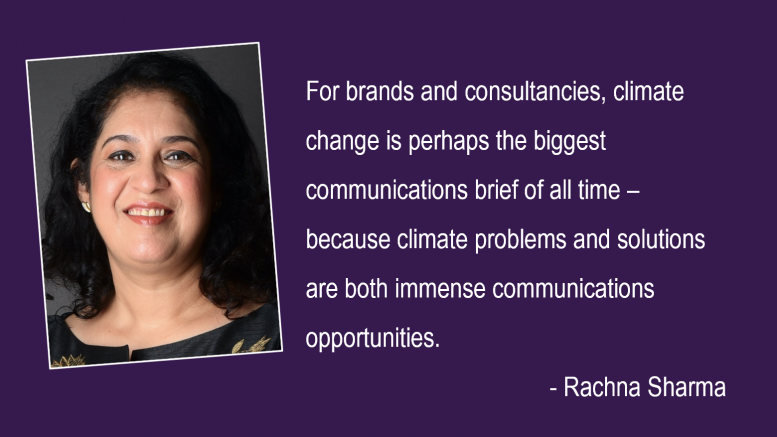Climate change will cause a foundational shift to our world and climate literate communications leaders have a key role to play.
The World Economic Forum (WEF) released the 2023 Global Risks Report recently that said seven of the 10 biggest global risks in the next 10 years are related to climate change. The report highlights risks to global GDP and about half of global GDP depends on nature today. Climate finally seems to have topped the business agenda at Davos and among the new initiative highlights was WEF announcing the goal to unlock $3 trillion for The Giving to Amplify Earth Action (GAEA) to restore nature and address climate change.
Climate change not only presents a grave risk and threat to the reputation of businesses everywhere, it threatens their very existence.
The world has embarked on a transition to a low carbon future to solve the problem, in what is being dubbed ‘the biggest peacetime transformation of the global economy.”
A shift that will be as transformational for our world as the internet.
Much like the internet has defined the past three decades, disrupted every sector, flipped over industry after industry and created the internet economy, climate change is similarly causing a tectonic shift in our world and birthing a new climate economy.
Solving for climate change means governments, businesses and individuals will need to embark on a journey towards sustainable businesses and sustainable lifestyles. Facilitating this journey presents an enormous opportunity for communicators to build reputable, resilient businesses and a better future for society as a whole.
For brands and agencies climate change is perhaps the biggest communications brief of all time – because climate problems and solutions are both immense communications opportunities.
Let’s take an example. Our food contributes about 25% of all greenhouse gas emissions causing climate change. Food waste is a significant component of these emissions and one third of the world’s food is wasted. According to the United Nations Environment Program’s 2021 Food Waste Index Report, India wastes 50 kilograms of food per person per year adding up to 68 million tons of food a year. How can brands and consumers collaborate and co-create solutions to reduce food waste? How can communicators and marketers facilitate this process?
Solving the food waste problem is even more critical since food security itself is a serious threat due to global warming. Food grows in a very narrow band of temperature and heatwaves are threatening food production. So another climate fix for food emissions is to grow and eat more heat resistant foods. Millets like ragi, jowar, bajra are highly nutritious and a climate friendly way forward. India is also the largest producer of millets and at the country’s behest 2023 has been declared by the United Nations as the International Year of Millets. How can brands in this space engage with consumers and work together to increase adoption of these climate friendly foods?
It is worthwhile to note, two thirds of all global emissions come from our lifestyles. The Intergovernmental Panel on Climate Change (IPCC) lists 61 climate friendly behaviours that can be adopted to make a difference. India has announced the Mission LiFE (Lifestyle for Environment) program recently that aims to increase awareness of 75 eco-friendly behaviours in food, transport, energy, retail, fashion and associated areas of waste and water. Several of these solutions are communications opportunities to build brand, engage consumers, protect business reputation and create climate resilient businesses while solving the larger climate problem.
Beyond engaging with the consumer, though, the changes a corporate needs to make on its climate and sustainability journey need to be deeper. Increasing regulation is demanding companies assess how they are impacting the environment and then lower their carbon footprint- SEBI has recently mandated Business Responsibility and Sustainability Reporting for top 1,000 listed companies.
Responsible corporates have initiated strategic sustainability journeys and are charting the way forward through Environment, Social and Governance (ESG) initiatives. Several are now documenting progress in their sustainability reports. Communicating these sustainability efforts and reports needs communicators to have a demystified understanding of what climate and sustainability means for particular industries before they can craft suitable content for outreach, both internally and externally. As government and businesses ramp up the sustainability agenda, creative, media, digital and communications agencies can expect a plethora of new briefs and opportunities to be coming their way and must particularly be prepared to create impactful work.
The climate crisis is relentless and the shift to a low carbon future is inevitable.
‘Sustainability’ is not a trend. It is the direction our future is taking and must take. New policies and regulations will continue to push organizations towards becoming low carbon emitting, sustainable businesses while encouraging sustainable and climate friendly individual behaviours.
The communicators can be facilitators in this critical journey. To become communications leaders of tomorrow it is imperative for them to become climate literate and understand the momentous shift underway. They can, then, become true, strategic advisers to their clients and businesses.
‘The most powerful person in the world is the storyteller,” said Steve Jobs. “The storyteller sets the agenda for a whole generation.” Communicators hold immense power today to decide how well the world moves towards sustainability and solves climate change. They get to do more than to save business reputation. They get to save the world.
The views and opinions published here belong to the author and do not necessarily reflect the views and opinions of the publisher.



Be the first to comment on "Why Climate Learning is Essential for Communicators Today"